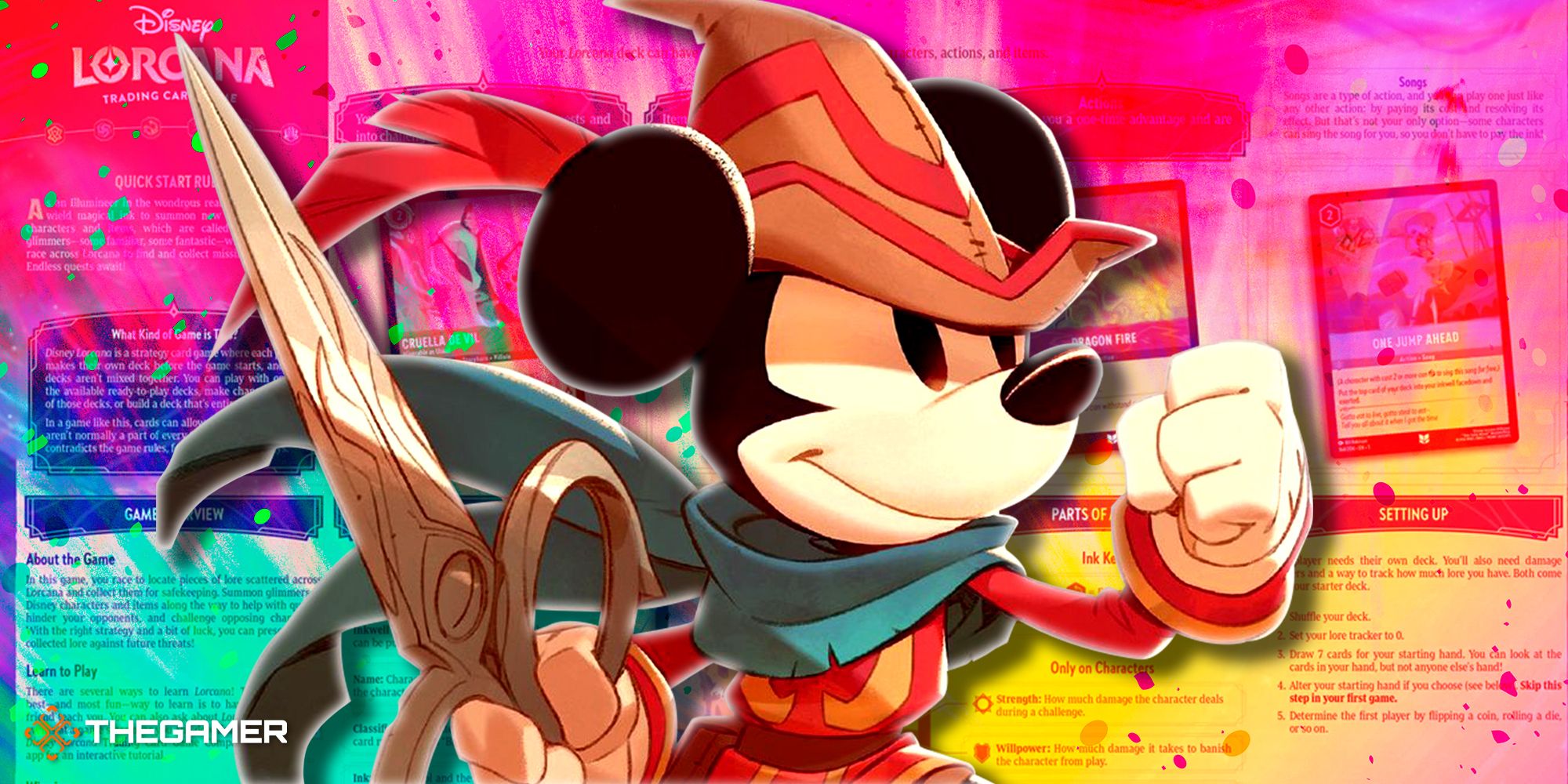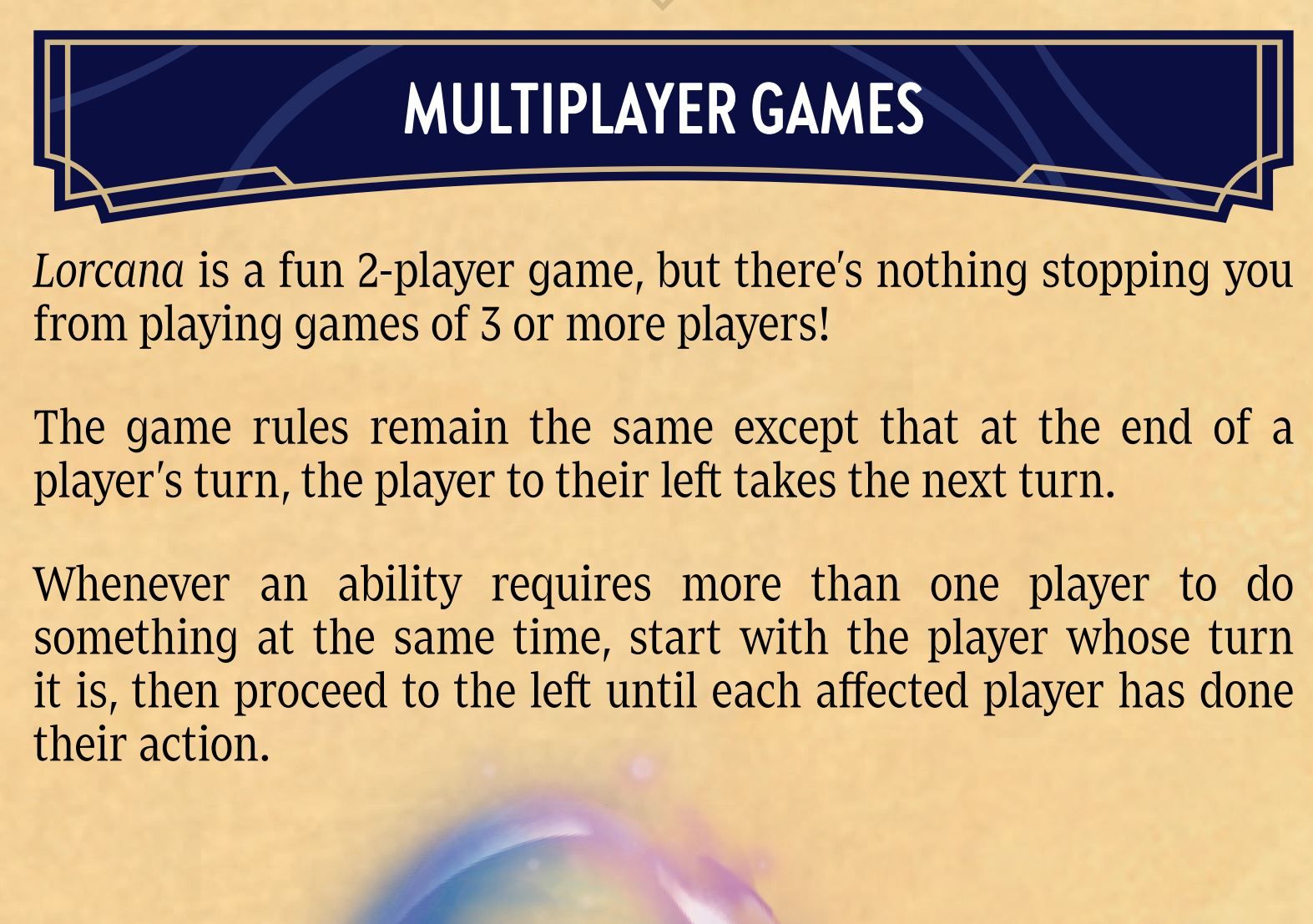The Disney Lorcana rules have finally been revealed, and it’s a lot to take in. While the game doesn’t launch until August 18, we finally have everything we need to start analyzing cards and theorycrafting some decks. After pouring over the rulebook and the already-revealed cards, I’ve noticed a few details that can be easy to overlook. As Ravensburger reveals more cards in the lead up to the full release, keep these details in mind; they may help you get a head start on building strong, creative decks.
There’s No Player Limit
There’s a little box in the rulebook that explains how multiplayer works, which will likely surprise TCG fans. You can’t play Pokemon with more than two people, and Magic has an entirely separate game mode for multiplayer, but with Lorcana, it’s built right into the core game.
What makes Lorcana so flexible is its unique win condition. Instead of attacking your opponent or their minions to chip away at their health, your goal is to accumulate 20 Lore points by sending your Glimmers on Quests. Each player is racing to earn Lore first, and can interfere with each other’s efforts too. This is what allows Lorcana to scale infinitely for as many players as you have. Instead of alternately between two players, each player will take their turn in a clockwise order.
Some decks that are strong against one player may not work as well against three, four, or even more players. You may need to adjust your deck or build entire new ones depending on the number of people you’re playing against. Entire families can play Lorcana together too, which is exactly what a Disney TCG should do.
There’s Two Ways To Win
The Game Overview section of the rule book explains that the first player to gain 20 Lore wins, but there’s another section later on called Ending The Game that reveals there is actually a second way to win. If your opponent (or opponents in a multiplayer game) run out of cards to draw, they automatically lose.
This opens the door for a couple of deck archetypes that are popular in other TCGs: Control and Mill. Control decks are designed to hold your opponent down and prevent them achieving their win condition. Your goal is to suppress them until they run out of options, which gives you an easy win. We’ve seen some cards that would be suited for a Control-style deck already, like Elsa whose Freeze ability forces an opponent’s character to Exert and opens them up to be Banished, or Dragon Fire, a Action card that can Banish characters. With more hard removal and character manipulation abilities, we could see powerful decks built around the idea of eliminating your opponents options until they run out of cards.
Mill is a more aggressive archetype, which forces your opponent to dump cards from their deck straight into their discard pile so that they run out before you do. None of the cards revealed so far have any kind of Mill mechanic, but there’s still a possibility we’ll see it in the future.
Only Exerted Cards Can Be Challenged
This is a core mechanic of combat in Lorcana, but it can be easy to forget since most TCGs don’t work this way. Exert is Lorcana’s version of MTG’s tapping, and you’ll need to Exert your Glimmers any time you want them to Quest (to gain Lore) or Challenge (to attack your opponents cards). Any card you Exert stays Exerted until your next turn, and your opponent can only challenge cards that you Exert. It doesn’t matter why they were Exerted, but a card has to be sideways on the board in order to be challenged.
Since you collect Lore immediately after Exerting a card, some are speculating that a powerful strategy will be to build an entire board until you have enough Lore Value to win in one turn. While it’s possible this could be a valid strategy, keep in mind that your opponent will have plenty of tools available to stop you from filling up your board. The aforementioned Elsa and Dragon Fire cards are both capable of eliminating your Glimmers, even if you never Exert them yourself, while Lady Tremaine’s Do It Again! Ability can help your opponent regain useful action cards and use them against you again.
It will always be risky to try to race your opponent without trying to get in their way with your own Challenges, but as we learn about more cards that circumvent Exert, we may find this strategy doesn’t work at all.
Collected Lore Can Be Stolen Or Destroyed
This one is extremely easy to miss since it comes in the About the Game section, which many will gloss over, thinking it's just a generic outline of what Lorcana is about. The last line of this section reads “With the right strategy and a bit of luck, you can preserve your collected lore against future threats!”
Lore is the primary win condition, and the player who collects 20 Lore first wins. We know there are ways to stop your opponent from collecting Lore, like challenging their Glimmers to Banish them from the board, but this line indicates that we will also be able to steal or destroy our opponents’ Lore after they’ve collected it too. We haven’t seen any cards with abilities like that, but there’s still a lot of cards to be revealed. Perhaps a version of Aladdin, Robin Hood, or Flynn Rider will be the thief we’re looking for.
Every Card Is Two-Sided
This is a cool detail I like to point out for anyone that hasn’t noticed yet. Lorcana’s resource system for playing cards is called Ink, and rather than include Energy or Land cards like other TCGs, you instead turn your normal cards into Ink and add them to your Inkwell. As long as a card has a Inkwell Icon around their cost, that card can be turned into Ink by putting them into your ‘inkwell’ face down.
Once a card becomes Ink, none of its card details matter any more. Every card is exactly the same when it becomes Ink, regardless of its cost. This is easy to recognize, because every card has the exact same back.
Having a uniform card back is necessary to keep cards secret, but it serves a double function here. The art on the back of Lorcana cards features the game’s logo and the six types of Ink, which just so happens to make it a perfect representation of Ink itself. Lorcana cards have a back and a front, but since they can be played Ink-side up, they’re actually reversible. Maybe not as impressive as Magic’s Double-faced cards, but still a cool detail.
Songs Make The Perfect House Rule
This one is just a bonus, since it isn’t technically part of the rules. Songs are a type of Action card revealed in the rule book, and while they function similar to other Action cards, they have one special ability. If you currently control a character that matches the requirements on the Song, you make that character sing the song, Exert them, and play it for free.
The Song featured in the rule book is One Jump Ahead from Aladdin. Any character you control with cost two or more can sing the song for free. Almost every Glimmer we’ve seen so far would qualify, including Aladdin, but you can also make Mickey Mouse, Goofy, Tigger, Elsa, and Stitch sing One Jump Ahead, among others.
So here’s a fun house rule: any time a player makes a character sing a song, they have to sing that song in that character’s voice. As much fun as it is to imagine Goofy singing Under the Sea or Olaf singing I Can’t Wait To Be King, it would be even more fun to hear your friends and family try to sing it like they would. If they have the guts to perform, maybe you can even let them find a bonus Lore on their next Quest as a reward.






